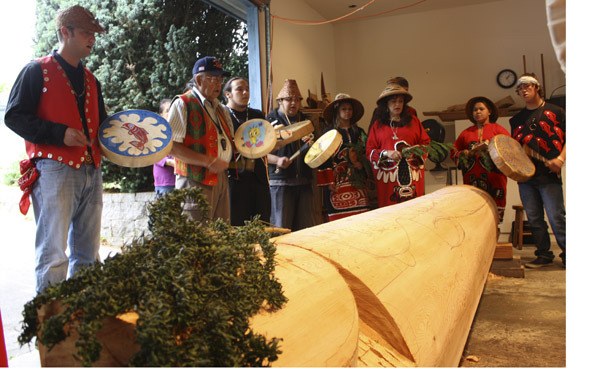At the end of a quiet gravel road near the north end of Vashon last week, a small group of Quileute tribal members engaged in a centuries-old tradition.
Surrounding two large cedar logs at Tlingit master carver Israel Shotridge’s home studio, the dozen Quileute people who came from from La Push sang songs of prayer, strength and thanks — prayer to the spirit of the tree, strength for Shotridge and thanks for the tree and the time Shotridge would spend transforming it into the totem poles of an archway at one of the tribe’s most sacred sites, the cemetery where their Quileute ancestors are buried.
Dressed in traditional ceremonial outfits of red, black and white — some wearing more modern jeans and sneakers underneath — the tribal members both young and old who came to Shotridge’s studio for a public blessing and commencement ceremony beat drums and sang words that had been passed down through generations.
At times the women danced around the trees, which were graced with ceremonial cedar branches, and several tribal leaders addressed Shotridge and the small group of Islanders that gathered to witness the ceremony.
George Samuel, a Quileute elder, spoke solemnly and slowly of the tree’s spirit. “It’s going to be chopped, but the spirit is still here, still strong,” he said.
Shotridge, also dressed in traditional clothing, soaked up the scene with a look of reverence and addressed the Quileute in return, thanking them for bringing the ceremony to Vashon where he would create the archway.
“I will have your songs in my heart as I carve,” he said.
Though Shotridge, a Ketchican native and highly respected Tlingit carver, has lived and worked on the Island for 15 years, the cemetery archway will be his first project commissioned by a Washington tribe. Most of his work has been for tribes, organizations and private collectors in his home state of Alaska.
The carver, a warm man who speaks with humility about his skills, said he was chosen from a handful of Native American artists by the Quiluete tribal council to carve the archway, which will include two 15-foot totem poles and a 30-foot canoe facade.
“I feel honored to be chosen by the Quileute people,” Shotridge said. “This is a very big deal for them.”
Shotridge’s wife Sue Shotridge, who runs Shotridge Studios as well as the Raven’s Nest Studio and Gift Shop on Vashon Highway, believes her husband was chosen by the Quileutes because he has carved for 30 years and proven himself a highly skilled artist. His totems and other work, she said, are installed all over the United States and even internationally.
“He’s very talented and accomplished,” Sue Shotridge said. “They chose him because of his capability. They wanted one of the best.”
Shotridge, however, is modest about his role in the creation of the archway, saying that he learned at a young age that such projects are bigger than himself.
“I’m their hands,” he said. “My efforts are to help their vision come true. … I’m playing a real small part in the bigger and much broader picture.”
The completed totems will feature a male and female figure on each pole, one holding a seal and the other a salmon — animals that Shotridge said have provided for the Quileute people and represent the cycle of life. The canoe featured in the facade symbolizes not just the Quileute’s traditional mode of transportation, but how the people, according to tribal beliefs, are transported to the next world after death.
Island historian Bruce Haulman has known the Shotridges for many years and attended last week’s ceremony. He said it’s exciting to see the Island artist carve the archway, not only because such projects are rare in the state but because of the history behind the archway’s intricate design.
Haulman said he was amazed to learn that some of the designs on the archway are based on drawings done by young Quileute people living at boarding schools in the early 1900s. Shotridge discovered the drawings while researching Quileute art at the Seattle Art Museum.
“That’s a powerful story that these kids had been taken away from their families and put in boarding schools but retained this cultural memory and drew these things on school paper,” Haulman said. “That’s a goosebumps moment.”
Shotridge will complete the project with the aid of his nephew, who currently acts as his apprentice, as well as a few new apprentices from the Quileute tribe. The Quileute do not have their own carvers but hope Shotridge will help teach the craft to some of the tribe’s budding artists.
The Shotridges are also giving Islanders the opportunity to follow the project, as Israel will open his studio by appointment to visitors on Fridays through December.
“It’s an exciting project that a lot of people are interested in,” Sue Shotridge said. “He often does some significant project like this happen on Vashon? It doesn’t, and if it does it should be open to the public.”
Haulman agreed that it is an exciting opportunity for Vashon — “just to be able to see a work in progress, to drop in and see how things are developing,” he said.
He’s also looking forward to seeing Shotridge work with the young Quileute artists.
“To have these Quileute emerging artists working with him — it’s an exiting kind of cultural exchange among tribal groups,” Haulman said.
Israel Shotridge will open his studio on Fridays through December for visitors to view the progress of the archway. To schedule a visit, stop by Raven’s Nest Studio at Vashon Highway and Cemetery Road, or call Sue Shotridge at 200-3302.



